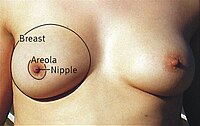
Photo from wikipedia
Background Fat grafting has become a popular procedure in aesthetic and reconstructive surgeries due to its safety, minimal invasiveness, and favorable visual outcomes, although the volume retention rate is unpredictable.… Click to show full abstract
Background Fat grafting has become a popular procedure in aesthetic and reconstructive surgeries due to its safety, minimal invasiveness, and favorable visual outcomes, although the volume retention rate is unpredictable. Objectives A prospective clinical study on lipoaugmentation of the breast was conducted to compare fat retention rates in the pectoralis muscle and the periglandular area. Methods This prospective study included 20 breasts from 11 patients who underwent primary lipoaugmentation. Volume retention rate and percentage augmentation among different recipient layers, as well as complications and patient satisfaction, were evaluated. Magnetic resonance imaging was performed preoperatively and at 1 day and 3 months postoperatively. Complications were recorded, and patient satisfaction was appraised through the use of the Breast-Q questionnaire. Results Breasts were injected with 207 ± 29 mL of fat, achieving overall volume retention rates of 56.63% ± 16.40%. The overall augmentation was 21.53% ± 10.27%. Volume retention rate was significantly higher (59.00% ± 13.84%) in the periglandular area than in the pectoralis muscle (47.21% ± 22.41%) (P = 0.04). Augmentation was significantly higher (32.13% ± 12.96%) in the periglandular area than in the pectoralis muscle (4.95% ± 4.23%) (P = 0.00). Pain and numbness were the only reported complications. The Breast-Q score increased significantly for the measures "satisfaction with breasts," "psychosocial well-being," and "sexual well-being." Conclusions Fat transfer is a safe and acceptable method for aesthetic and reconstructive breast surgery. The periglandular area was a better recipient site than muscle for transferred fat. Level of Evidence 4
Journal Title: Aesthetic surgery journal
Year Published: 2018
Link to full text (if available)
Share on Social Media: Sign Up to like & get
recommendations!